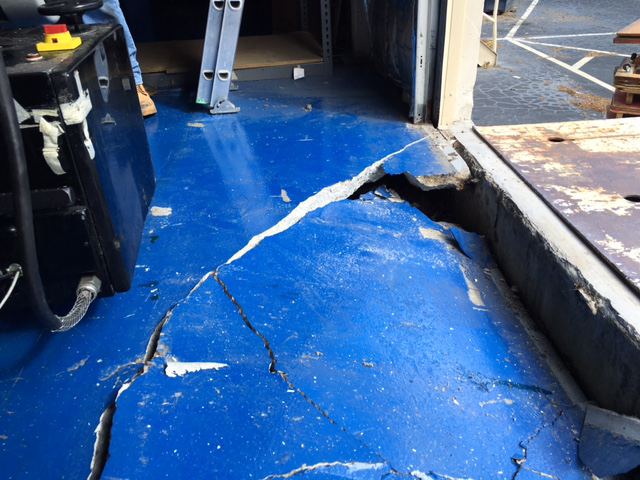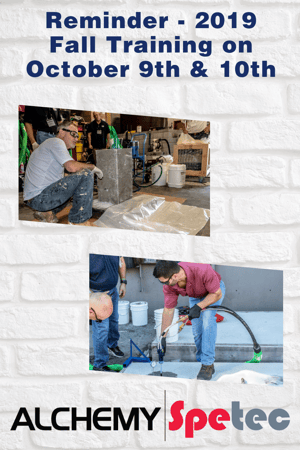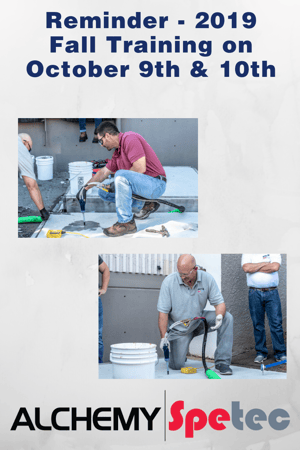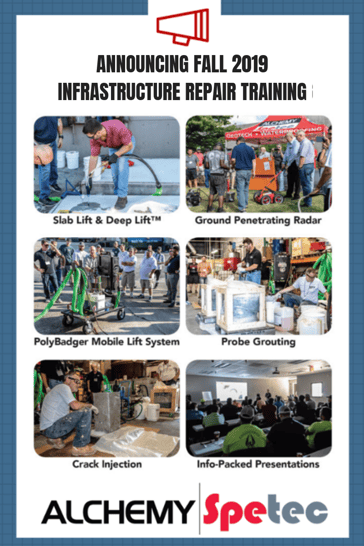
.png?width=300&name=Loading%20Dock%20Slab%20Repair%20(1).png) Sunken concrete slabs can be lifted back into place with two-component polyurethane foams designed to work in wet or dry conditions. The expansion force of the concrete leveling foam coupled with the pressure of a specialized pump generate enough controlled force to lift virtually any structure back into position with 1/8” precision.
Sunken concrete slabs can be lifted back into place with two-component polyurethane foams designed to work in wet or dry conditions. The expansion force of the concrete leveling foam coupled with the pressure of a specialized pump generate enough controlled force to lift virtually any structure back into position with 1/8” precision.
- From the Alchemy-Spetec blog post Polyurethane Slab Lifting Explained. (Read more and watch an animation that explains the slab lifting process in detail.)
If you own or manage a facility with loading docks, it is essential to understand the dangers of unstable concrete. Warning signs include rocking, cracking, and unlevel seams between slabs. If you notice any of these red flags, you need to contact a professional concrete repair contractor immediately. (For assistance on that front, contact Alchemy-Spetec at 404-618-0438.)
This very real risks of ignoring unstable loading dock slabs include:
- Damage to vehicles and equipment.
- Personal property damage.
- Sudden slab collapse.
- Trip hazards.
- Employee injuries.
- Limitless liability issues.
As industry experts consulting with contactors around the world, we've seen all these scenarios play out unfortunately. Here's a photo from a slab collapse that prompted the owners to call in a contractor to inspect and stabilize the rest of their slabs...

Don't wait for this to happen on your property. Contact Alchemy-Spetec at the first sign of any issue and let us help you find a contractor in your area! Call now at 404-618-0438.
Want more information on warehouse & industrial slab repair?

Topics:
All Posts,
Lift Slabs,
Stabilize Soil
-2.png?width=1400&name=Reminder%20-%202019%20Fall%20Training%20on%20October%209th%20%26%2010th%20(1)-2.png)

You still have a chance to sign up for Fall 2019 Training while there are still spots left. Don't miss this critical opportunity to turbo-charge your business!

October 9th & 10th, 2019 at Alchemy-Spetec HQ in Tucker, GA
Get ready for a thorough education in Leak Seal, Slab Lifting, Soil Stabilization and the Alchemy-Spetec Deep Lift™ process. You’ll get hands-on training from a technical staff with decades of on-the-job experience.
Wednesday - Leak Seal
- Leak Seal Product Line Overview
- Curtain Grouting
- Permeation Grouting
- Leak-Seal Product Mixing
- Pump & Packer Overviews
- Leak-Seal Accessories
- Municipal Applications
- Live Injection Demos
- Open Discussions
Thursday - Geotech
- Geotech Product Line Overview
- Soil Stabilization
- Geotech Product Mixing
- Rig & Mobile System Overviews
- Geotechnical Accessories
- Slab Lifting Live Demo
- Deep Lift™ Overview
- Soil Testing with the
- GPR & Penetrometer
- Maintenance Discussions
- Pricing / Estimating / Cost Savings
- Open Discussions

Participants receive a Samsung tablet loaded with training material.
Your Instructors:
Stephen C. Barton (President/CEO), Jim Spiegel (VP Sales & Business Development), Andy Powell (Southeastern Regional Manager), Anthony Sandone (Eastern Regional Manager), Charlie Lerman (Western Regional Manager), and Michael Binyaminov (Western Sales Representative).
Topics:
Repair Seawalls,
Equipment & Accessories,
All Posts,
Lift Slabs,
NSF Certification,
Seal Leaks,
Stabilize Soil,
Business Tips,
Repair Cracks,
Waterstop,
Deep Lift,
Floor Repair,
Fill Voids,
Engineer Resources
-1.png?width=1400&name=Reminder%20-%202019%20Fall%20Training%20on%20October%209th%20%26%2010th%20(1)-1.png)

Sign up for Fall 2019 Training while there are still spots left!

October 9th & 10th, 2019 at Alchemy-Spetec HQ in Tucker, GA
Get ready for a thorough education in Leak Seal, Slab Lifting, Soil Stabilization and the Alchemy-Spetec Deep Lift™ process. You’ll get hands-on training from a technical staff with decades of on-the-job experience.
Wednesday - Leak Seal
- Leak Seal Product Line Overview
- Curtain Grouting
- Permeation Grouting
- Leak-Seal Product Mixing
- Pump & Packer Overviews
- Leak-Seal Accessories
- Municipal Applications
- Live Injection Demos
- Open Discussions
Thursday - Geotech
- Geotech Product Line Overview
- Soil Stabilization
- Geotech Product Mixing
- Rig & Mobile System Overviews
- Geotechnical Accessories
- Slab Lifting Live Demo
- Deep Lift™ Overview
- Soil Testing with the
- GPR & Penetrometer
- Maintenance Discussions
- Pricing / Estimating / Cost Savings
- Open Discussions

Participants receive a Samsung tablet loaded with training material.
Your Instructors:
Stephen C. Barton (President/CEO), Jim Spiegel (VP Sales & Business Development), Andy Powell (Southeastern Regional Manager), Anthony Sandone (Eastern Regional Manager), Charlie Lerman (Western Regional Manager), and Michael Binyaminov (Western Sales Representative).
Topics:
Repair Seawalls,
Equipment & Accessories,
All Posts,
Lift Slabs,
NSF Certification,
Seal Leaks,
Stabilize Soil,
Business Tips,
Repair Cracks,
Waterstop,
Deep Lift,
Floor Repair,
Fill Voids,
Engineer Resources
.png?width=1400&name=Reminder%20-%202019%20Fall%20Training%20on%20October%209th%20%26%2010th%20(2).png)
.png?width=300&name=Reminder%20-%202019%20Fall%20Training%20on%20October%209th%20%26%2010th%20(1).png) Don't forget to sign up for Fall 2019 Training!
Don't forget to sign up for Fall 2019 Training!

October 9th & 10th, 2019 at Alchemy-Spetec HQ in Tucker, GA
Get ready for a thorough education in Leak Seal, Slab Lifting, Soil Stabilization and the Alchemy-Spetec Deep Lift™ process. You’ll get hands-on training from a technical staff with decades of on-the-job experience.
Wednesday - Leak Seal
- Leak Seal Product Line Overview
- Curtain Grouting
- Permeation Grouting
- Leak-Seal Product Mixing
- Pump & Packer Overviews
- Leak-Seal Accessories
- Municipal Applications
- Live Injection Demos
- Open Discussions
Thursday - Geotech
- Geotech Product Line Overview
- Soil Stabilization
- Geotech Product Mixing
- Rig & Mobile System Overviews
- Geotechnical Accessories
- Slab Lifting Live Demo
- Deep Lift™ Overview
- Soil Testing with the
- GPR & Penetrometer
- Maintenance Discussions
- Pricing / Estimating / Cost Savings
- Open Discussions

Participants receive a Samsung tablet loaded with training material.
Your Instructors:
Stephen C. Barton (President/CEO), Jim Spiegel (VP Sales & Business Development), Andy Powell (Southeastern Regional Manager), Anthony Sandone (Eastern Regional Manager), Charlie Lerman (Western Regional Manager), and Michael Binyaminov (Western Sales Representative).
Topics:
Repair Seawalls,
Equipment & Accessories,
All Posts,
Lift Slabs,
NSF Certification,
Seal Leaks,
Stabilize Soil,
Business Tips,
Repair Cracks,
Waterstop,
Deep Lift,
Floor Repair,
Fill Voids,
Engineer Resources

.png?width=300&name=Jump%20Start%20Your%20New%20Concrete%20Leveling%20Business%20with%20Alchemy-Spetecs%20Fall%202019%20Training%20(1).png) Jump start your concrete leveling business at Alchemy-Spetec's Fall 2019 Training! As stated in our blog post on Starting a Slab Lifting Business...
Jump start your concrete leveling business at Alchemy-Spetec's Fall 2019 Training! As stated in our blog post on Starting a Slab Lifting Business...
We can start you on the journey of total preparation for success in slab lifting. Our experienced technical consultants can educate you on the causes of settled slabs, the process of repairing them, and critical facts about the polymer material on which your jobs will rely. You'll learn about trailer rig options, the MixMaster slab lifting gun, pump options and accessory equipment. We also offer tips on markering your business, estimating materials for jobs, and essential techniques for avoiding on-the-job problems.
In addition, you'll get an overview of polyurethane leak seal products and procedures! Here's a complete schedule for both days...
Wednesday Oct. 9th - Leak Seal
- Leak Seal Product Line Overview
- Curtain Grouting
- Permeation Grouting
- Leak-Seal Product Mixing
- Pump & Packer Overviews
- Leak-Seal Accessories
- Municipal Applications
- Live Injection Demos
- Open Discussions
Thursday Oct. 10th - Geotech
- Geotech Product Line Overview
- Soil Stabilization
- Geotech Product Mixing
- Rig & Mobile System Overviews
- Geotechnical Accessories
- Slab Lifting Live Demo
- Deep Lift™ Overview
- Soil Testing with the
- GPR & Penetrometer
- Maintenance Discussions
- Pricing / Estimating / Cost Savings
- Open Discussions

Topics:
All Posts,
Lift Slabs,
Business Tips

.png?width=300&name=Blog%20Outfitting%20a%20Spray%20Foam%20Rig%20for%20Slab%20Lifting%20(2).png)
We’re often contacted by spray foam contractors looking to add slab lifting to their skill set. One of the first questions we’re asked is “what new equipment do I need?” The answer is “not much”. With just a few pieces of new equipment, an existing spray foam rig can be converted for slab lifting. Here’s all the equipment you need:
- MixMaster Pro Slab Lifting Gun with Ports
- Titan 440 Flush Pump with Hose
- Dial Indicator Stand
Don’t bring a knife to a gunfight! Spray foam insulation guns are made for the simple process of spraying foam at constant pressures. The MixMaster Pro slab lifting gun designed to deal with changing pressures and back pressure without backing up or crossing over. Issues like leaky port connections, constant cleaning, and constant fumbling around with a clamp can drastically reduce production - adding a lot of man hours to each project. Not to mention long nights spent rebuilding and cleaning the gun after EVERY job. Kiss all that goodbye, with a leak-proof gun that handles back pressure and is bulit to last! The Titan 440 is a pre-grout injection water flush pump for flushing Alchemy-Spetec’s MixMaster slab lifting gun. The Dial Indicator Stand provides real-time lift measurement during the concrete slab leveling process.
For more guidance on getting into the slab lifting business, contact Alchemy-Spetec’s industry-leading tech support team at 404-618-0438.
Want more information on equipping a rig for slab lifting?

Topics:
Equipment & Accessories,
All Posts,
Lift Slabs,
Business Tips


Get ready for a thorough education in polyurethane slab lift/soil stabilization geotech products and applications on Thursday, October 10th (October 9th is leak seal day), 2019 at Alchemy-Spetec HQ in Tucker, GA. You’ll get hands-on training from a technical staff with decades of on-the-job experience. Registration includes both days, but we’ll take a close look at the geotech curriculum in today’s blog post…
The schedule on Thursday, October 10th includes education on the Alchemy-Spetec geotech product line, soil stabilization, slab lifting, the Deep Lift™ process, rig & mobile lifting systems, geotech accessories, soil testing (ground penetrating radar, penetrometer), pricing and estimating. There will also be live geotech demos, product mixing demos, and open discussions for sharing job related tips and solutions from the field.
Your instructors have years of experience providing technical support for contractors across the country. You can look forward to presentations, demos and/or discussions lead by Stephen C. Barton (President/CEO), Jim Spiegel (VP Sales & Business Development), Andy Powell (Southeastern Regional Manager), Anthony Sandone (Eastern Regional Manager), and Charlie Lerman (Western Regional Manager).
Participants will receive a Samsung tablet loaded with leak seal training material.
Sign up while there's still space available...

Topics:
Equipment & Accessories,
All Posts,
Lift Slabs,
Stabilize Soil,
Business Tips,
Deep Lift

.png?width=300&name=Blog%20Slab%20Lift%20Product%20Bundles%20Expire%20August%2031st%20(1).png) Don't miss out on the AP Lift 430 and MixMaster Pro slab lifting gun product bundle offer!
Don't miss out on the AP Lift 430 and MixMaster Pro slab lifting gun product bundle offer!
AP Lift 430 Concrete Leveling Foam
AP LIFT 430 is a two component, high strength, high density, hydro insensitive slab lifting foam.
- Traffic ready in 15 minutes.
- High strength.
- Works in wet environments - displaces water.
- Bonds with soil and concrete.
- Closed cell.
- Certified by Truesdail Labs to NSF/ANSI 61-5 (approved for contact with drinking water).
MixMaster Pro Concrete Leveling Gun
Two-component resin injection gun manufactured specifically for lifting concrete slabs, designed to handle back-pressure. As the essential piece of foam jacking equipment for Alchemy-Spetec’s expanding polyurethane foams, the resin injection gun provides highly-efficient concrete leveling.
- Completely mechanical actuation
- No side seals or O-rings in the mixing block to replace
- Integrated rebuildable check valves to save your whip hose
- Easy break down and clean up at the end of the day
- Utilizes smaller 3/8” injection port
- Uses water based flush

Call 404-618-0438 to order your Slab Lift Product Bundle NOW!
Want more information on Alchemy-Spetec Geotech products?

Topics:
Equipment & Accessories,
All Posts,
Lift Slabs
.png?width=1400&name=Banner%20Bigger%2c%20Better%2c%20Stonger%20-%20The%20Stainless%20Steel%20MixMaster%20Gun%20Block%20(1).png)
.png?width=300&name=Blog%20Bigger%2c%20Better%2c%20Stonger%20-%20The%20Stainless%20Steel%20MixMaster%20Gun%20Block%20(1).png)
The new stainless-steel block for the MixMaster Pro concrete leveling gun is an option you may want to consider. This stronger, more durable gun block was developed to prevent stripping of injector ports (which can sometimes happen with the aluminum block if the ports are over-tightened).
There are no problems with the aluminum block as long as all your crew members are trained not to over-tighten the ports. But if you would like that extra level of projection and durability, consider spending a little more for the stainless-steel option.
Want more info on the MixMaster Pro concrete leveling gun?

Topics:
Equipment & Accessories,
All Posts,
Lift Slabs

 Leak Seal & Geotech Products & Procedures
Leak Seal & Geotech Products & Procedures
October 9th & 10th, 2019 at Alchemy-Spetec HQ in Tucker, GA
Get ready for a thorough education in Leak Seal, Slab Lifting, Soil Stabilization and the Alchemy-Spetec Deep Lift™ process. You’ll get hands-on training from a technical staff with decades of on-the-job experience.
Wednesday - Leak Seal
- Leak Seal Product Line Overview
- Curtain Grouting
- Permeation Grouting
- Leak-Seal Product Mixing
- Pump & Packer Overviews
- Leak-Seal Accessories
- Municipal Applications
- Live Injection Demos
- Open Discussions
Thursday - Geotech
- Geotech Product Line Overview
- Soil Stabilization
- Geotech Product Mixing
- Rig & Mobile System Overviews
- Geotechnical Accessories
- Slab Lifting Live Demo
- Deep Lift™ Overview
- Soil Testing with the
- GPR & Penetrometer
- Maintenance Discussions
- Pricing / Estimating / Cost Savings
- Open Discussions

Participants receive a Samsung tablet loaded with training material.
Your Instructors:
Stephen C. Barton (President/CEO), Jim Spiegel (VP Sales & Business Development), Andy Powell (Southeastern Regional Manager), Anthony Sandone (Eastern Regional Manager), Charlie Lerman (Western Regional Manager), and Michael Binyaminov (Western Sales Representative).
Topics:
Repair Seawalls,
Equipment & Accessories,
All Posts,
Lift Slabs,
Seal Leaks,
Stabilize Soil,
Business Tips,
Repair Cracks,
Waterstop,
Deep Lift,
Floor Repair

.png?width=300&name=Loading%20Dock%20Slab%20Repair%20(1).png) Sunken concrete slabs can be lifted back into place with two-component polyurethane foams designed to work in wet or dry conditions. The expansion force of the concrete leveling foam coupled with the pressure of a specialized pump generate enough controlled force to lift virtually any structure back into position with 1/8” precision.
Sunken concrete slabs can be lifted back into place with two-component polyurethane foams designed to work in wet or dry conditions. The expansion force of the concrete leveling foam coupled with the pressure of a specialized pump generate enough controlled force to lift virtually any structure back into position with 1/8” precision. 


-2.png?width=1400&name=Reminder%20-%202019%20Fall%20Training%20on%20October%209th%20%26%2010th%20(1)-2.png)


-1.png?width=1400&name=Reminder%20-%202019%20Fall%20Training%20on%20October%209th%20%26%2010th%20(1)-1.png)

.png?width=1400&name=Reminder%20-%202019%20Fall%20Training%20on%20October%209th%20%26%2010th%20(2).png)
.png?width=300&name=Reminder%20-%202019%20Fall%20Training%20on%20October%209th%20%26%2010th%20(1).png) Don't forget to sign up for Fall 2019 Training!
Don't forget to sign up for Fall 2019 Training!
.png?width=300&name=Jump%20Start%20Your%20New%20Concrete%20Leveling%20Business%20with%20Alchemy-Spetecs%20Fall%202019%20Training%20(1).png) Jump start your concrete leveling business at
Jump start your concrete leveling business at 
.png?width=300&name=Blog%20Outfitting%20a%20Spray%20Foam%20Rig%20for%20Slab%20Lifting%20(2).png)




.png?width=300&name=Blog%20Slab%20Lift%20Product%20Bundles%20Expire%20August%2031st%20(1).png) Don't miss out on the AP Lift 430 and MixMaster Pro slab lifting gun product bundle offer!
Don't miss out on the AP Lift 430 and MixMaster Pro slab lifting gun product bundle offer!

.png?width=1400&name=Banner%20Bigger%2c%20Better%2c%20Stonger%20-%20The%20Stainless%20Steel%20MixMaster%20Gun%20Block%20(1).png)
.png?width=300&name=Blog%20Bigger%2c%20Better%2c%20Stonger%20-%20The%20Stainless%20Steel%20MixMaster%20Gun%20Block%20(1).png)


 Leak Seal & Geotech Products & Procedures
Leak Seal & Geotech Products & Procedures